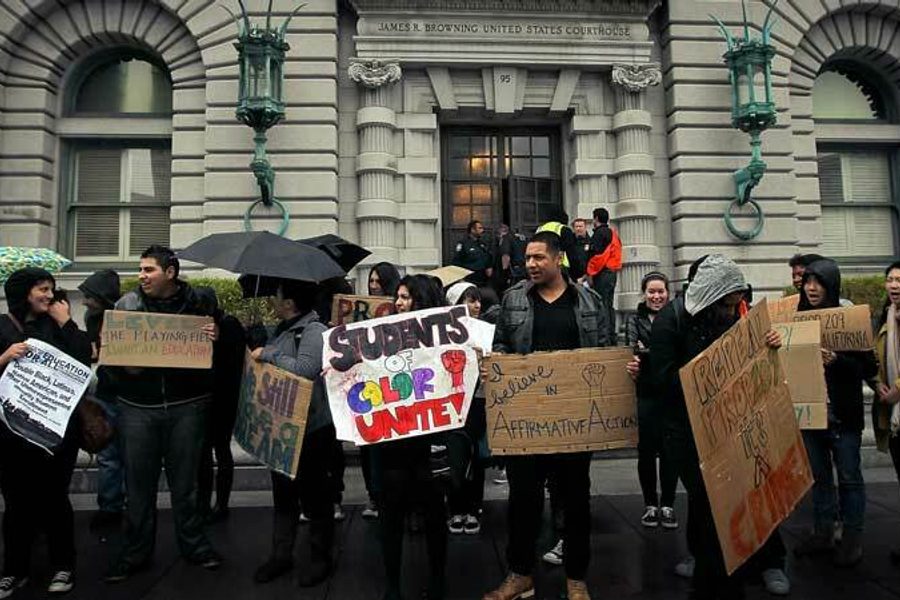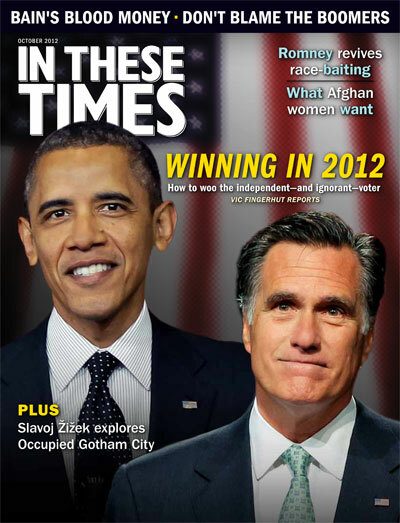
In our allegedly post-racial society, the future of affirmative action is looking bleak. In February, the U.S. Supreme Court agreed to hear a lawsuit brought by Abigail Fisher, a white student who, after she was rejected from the University of Texas, charged that the school had violated her Constitutional right to equal protection through its use of race as a factor in admissions. Arguments begin October 1.
Though the issue has long been a lightning rod for the Right, progressives are often divided over whether to rally behind race-based affirmative action or to push for alternatives that aim more directly at class inequality. As the Court prepared to hear the landmark case, In These Times gathered Donna Stern, national coordinator for By Any Means Necessary (BAMN), Richard Kahlenberg, a senior fellow at the Century Foundation, and Stephen Steinberg, an urban studies professor at Queens College, to discuss the history of and prospects for affirmative action as a strategy for racial and economic justice.
The Supreme Court is set to hear Fisher v. University of Texas this October. What’s at stake in this case?
Stephen: This case is going to determine the fate of diversity in higher education — there’s no doubt about that. But the purpose and logic of affirmative action — which was originally about rectifying occupational apartheid — has already been watered down to a focus on diversity for diversity’s sake. So this is really the last remnant of affirmative action, which has been eviscerated by the courts since the 1980s. What’s at stake is whether the Court is going to pound the last nail into the coffin.
Donna: BAMN believes that affirmative action is the desegregation plan for higher education. What we’re fighting for is not just diversity, but integration. Without race-based affirmative action, you will have a return of legalized Jim Crow through admissions criteria that give preference to white people from privileged backgrounds.
The University of Texas also has an affirmative action plan that guarantees admission to students who ranked in the top 10 percent of their high school classes. The lawsuit doesn’t challenge this plan, but could this plan be affected by the Supreme Court’s decision?
Donna: The fight in Fisher is just the tip of the iceberg — next we’re certainly going to see a fight over whether or not the 10 percent is legal. And we think it’s important to defend this plan alongside race-based affirmative action, because the 10 percent plan is the most egalitarian and transparent admissions process of any selective university in the nation. Together, the combined admissions program unites poor, rural white people from East Texas with Latinos and blacks.
Richard: And I’m disappointed that some on the Left are attacking the 10 percent plan in order to defend race-based affirmative action. I think that all the focus on race diverts attention from broader economic inequalities, at selective universities in particular. The University of North Carolina said in an amicus brief that it would be a disaster if they had to admit the top 10 percent in the state because their average student SAT would drop a mere 55 points, which is just silly. One way we can get universities to focus on the broader issue of class inequality is to take away the option of simply admitting wealthy and middle-class students of color.
Many progressives, going back to Bayard Rustin, have opposed race-based affirmative action policies on the grounds that they fracture alliances between blacks and working-class whites. Could affirmative action based on socioeconomic class provide the basis for a stronger coalition for economic justice?
Donna: While we’d like to see other universities adopt 10-percent plans, class-based affirmative action is not a substitute for race-based affirmative action.
Richard: It’s hard to imagine a better way to divide working-class people than a program that tells working- class whites, “An affluent person of color can benefit from this program, but you cannot.” This encourages white working-class people to vote for their race and not their class, which is disastrous. Class-based affirmative action can still increase minority enrollment and address indirectly our history of discrimination, but in a way that Americans can accept and the Supreme Court can accept.
Stephen: There is no doubt that affirmative action is divisive to the constituencies of the Left. It’s tempting, therefore, to sidestep the whole issue by proposing class-based affirmative action. But should we capitulate to white apathy and intransigence, and their outright hostility to affirmative action? Frankly, I see the class-based argument as a politically respectable diversion from confronting institutional racism, past and present.
Richard: The inception of affirmative action was the Philadelphia Plan, which imposed racial quotas on the construction industry in 1969. Members of the Nixon administration have explicitly said the Plan was a way to divide working class whites and blacks — and it worked brilliantly.
Stephen: I think affirmative action had a more complicated starting point; it was Nixon’s attempt to appease the civil rights movement at a time when he was waging war in Vietnam. And it’s very important to remember that the Philadelphia Plan grew out of grassroots activism and protests at construction sites.
Today, there is no similar movement that is pushing for class-based affirmative action. It is not really on the table as a policy alternative. Instead, I think the class-based argument originated as a rhetorical foil to trump the race card with the class card.
Some have also argued that affirmative action in higher education has sidelined other issues impacting poor black and Hispanic communities. Should defending affirmative action continue to be the main focus of racial justice movements?
Donna: I’m wary of arguments that we should be putting all of our energy into issues such as rates of incarceration, as opposed to education. Rates of incarceration and educational opportunities are directly correlated. And our concern is rebuilding the civil rights movement, and the leadership that we need is most likely to come from high school and college campuses. Fighting for affirmative action and defending public education from privatization are key to rebuilding a mass movement that can advance progressive policies.
Stephen: We have to fight on all fronts, but we also have to acknowledge the limits of what has dominated the discourse around affirmative action: who gets into the elite colleges and universities. This is the wrong question — it’s classist in its essence. Historically, affirmative action has been important in desegregating not just white-collar job sectors, but blue-collar industries as well.
Richard: But it does matter who goes to selective institutions. Our leadership class is disproportionately derived from them. The issue is hugely symbolic to people. It has to do with who’s going to get ahead in society, who’s going to enjoy the American dream, and that’s why this issue of racial preferences can be so divisive.
How will the issue of affirmative action play out in this year’s elections?
Richard: Obama missed a huge opportunity here. He has had a very nuanced position on affirmative action, saying that his own privileged daughters do not deserve it. And yet, in the brief filed with the Supreme Court, the Justice Department took a very traditional, race-based position. Almost all observers of the Supreme Court think that affirmative action is going to lose in this case. The president may take a real political hit for something that was going to lose anyway.
Donna: That said, BAMN has gotten very little support from the Obama administration for previous challenges in Michigan and California. This has been very consistent with the Democratic Party’s retreat to a white populist position that refuses to weigh in specifically on issues of racism. This is very dangerous because the fight for civil rights betters the situation of poor white people as well — historically, the struggles against slavery and for freedom and democracy are intertwined.
There has been relatively little noise from the Left around this case. How can a broader coalition be rebuilt around this issue?
Richard: Martin Luther King Jr., when he wrestled with the question of how to remedy the legacy of slavery and segregation, said that there should be a Bill of Rights for the disadvantaged, including poor whites. We have the opportunity today to come out in favor of the King position.
Donna: Affirmative action was won through the civil rights movement and through the united action of students, like those from the Black Action Movement at the University of Michigan. I think that we will only make further progress if white students and white workers are prepared to fight not only for the common economic demands that affect people from all races, but also for policies that will counteract racism.
Stephen: I’m willing to march with BAMN — even if the fight over higher education is limited. It’s all we have at the moment. We’re in a position today where there’s not only enduring but deepening inequality between blacks and everyone else, and that compels us as progressives to launch a frontal assault on these inequalities. We need to confront race as race, and to convince others to rally to that banner.
Rebecca Burns is an In These Times contributing editor and award-winning investigative reporter. Her work has appeared in Bloomberg, the Chicago Reader, ProPublica, The Intercept, and USA Today. Follow her on Twitter @rejburns.









